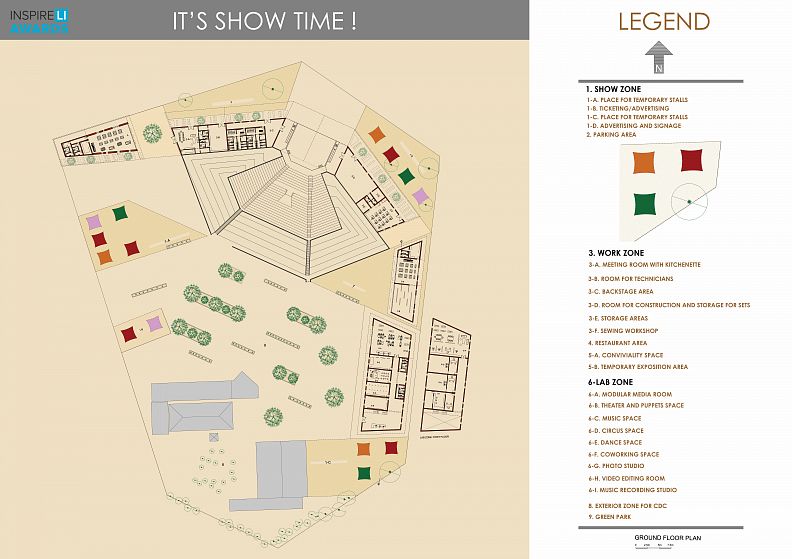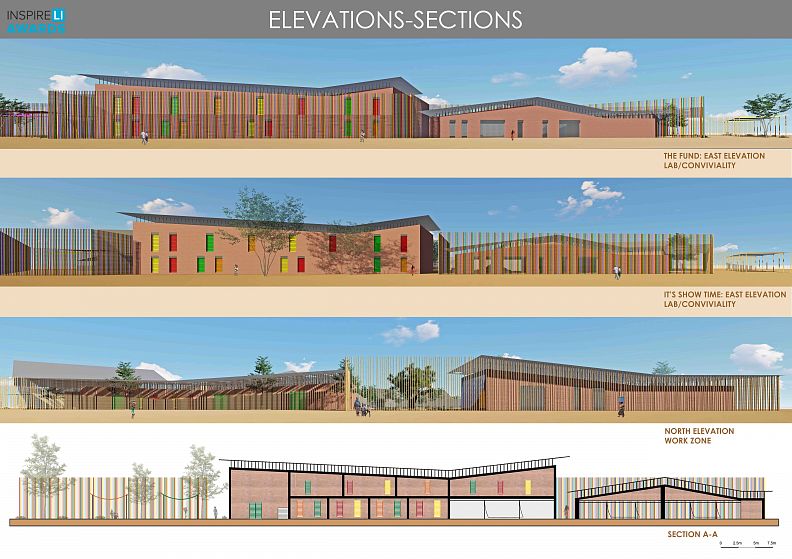An Urban Theater, A Theatrical City - Théâtre Populaire IDEA(L)

Project idea
The envelope of a place is a call to the physical experience of depth that we discover beyond this envelope. Its architectural form is distinguished from any other object because it generates a tension between the hollow, inhabited interior, and the infinite, indefinite exterior, also inhabited. The envelope constitutes a dynamic interface between the two worlds, a scene where there are continual passages of bodies, lights, views, and sounds. This place becomes intermediary, double-sided, inducing simultaneous relationships. This specificity gives architecture an aesthetic value shaped by the tensions or pressures that act on both sides of the envelope.
The idea explores ways that do not immobilize the African vernacular architecture and make it inaccessible, but that put it at the service of the theater, the CDC (Center for Choreographic Development), and the city. So I chose to build through a tool that is not static for vernacular architecture, but a social laboratory that works, installs, learns, shares crafts, and builds.
The project creates an expressive experience that restores the collective African imagination. Hence the theater becomes urban, and the city becomes theatrical. This overlap manifests itself thanks to the multifunctionality of the project. For this reason, I decided to live in the envelope.
‘Build your architecture of what is under your feet.’ Inspired by this quote of Hasan Fathy, I seek an ‘intelligent sustainability’ in the project, ensured not only by local materials but by the multifunctionality of the project, working in favor of the local community and the theater. Each facade works with its urban mirror (waste, greenery, water, sports center, and the market). The project, therefore, works on two scales: micro, in direct relation with the theater, and macro, concerning the city and the local community.
On the other hand, dance and architecture are two disciplines that use space as their raw material. Dance is the art of moving the human body according to coordination between space and time, hence, the scenic space becomes free and transformable, a rhythmic space that reveals itself and comes to life when in contact with moving bodies. Therefore, space lives in harmony with the person who practices it or invests in it. Dance is also the main symbol of African culture, which made it a source for my inspiration too. This mobility of the project is then ensured by an entity that works relating to time and space, from which I created a specific calendar to each ‘scene.’
Project description
The flexibility of the project is assured by two calendars. The first calendar is associated with working days, or production days, relating to users (CDC) from one side, and the urban area, in favor of the local population from another. It includes fixed functions (Work and Lab Zones). Towards the city, I created activities used for the continuous financing of the project and economic support of locals: sorting of waste, sewing, crafts, local products, etc. In specific times, the spaces become a souk. Also, the activity and souk spaces will become at night leisure spaces that can be used by the locals without affecting the interior of the project.
Towards the theater, I created the second calendar formed by the functions dedicated to ‘ShowTime’ and public events relating to the CDC and artists. In this case, the project works in favor of the popular theater and the CDC. These events can take place at different times, without affecting the fixed functions relating to (Work and Lab Zones). The entire site then becomes public.
This movable, dancing, vernacular-modern project, ensured by the change of the envelope, create third places, which blur the boundaries between public and private space. The goal is to build and live all together, in a sustainable project with two facets: architectural sustainability and social sustainability. The result is a collective lifestyle that escapes urban isolation. Burkina Faso, which represented an enclave, will be the ceremonial space for everyone and forever.
Technical information
The functions dedicated to the theater (the work zone (backstage) and the laboratory zone for artistic education) will present fixed volumes built with local bricks, and the functions intended for local community integration will be flexible and interacting with the surroundings. This envelope is built from local colored wooden rods, which are flexible, ecological, and will create a mobile envelope (sheets) from modules that are easy to shape and transport by humans. Fixed brick volumes are associated with a double roof, built from locally used metal sheets, assuring a cool climate. Flexible openings are built from PVC curtains and ‘locally used’ windows, while fixed openings are built from glass. The wood envelope forms not only a decorative structure but also a double skin or shading element that helps to keep a cool and comfortable atmosphere in hot seasons and to create gathering spaces. The envelope will be a call to the city, by its height and its variant colors, forming a symbol of African culture. All the remaining space will be the large planted courtyard or square, forming an ecological atmosphere, and a sign of the historical culture and collective memory of the population of Burkina Faso.


















